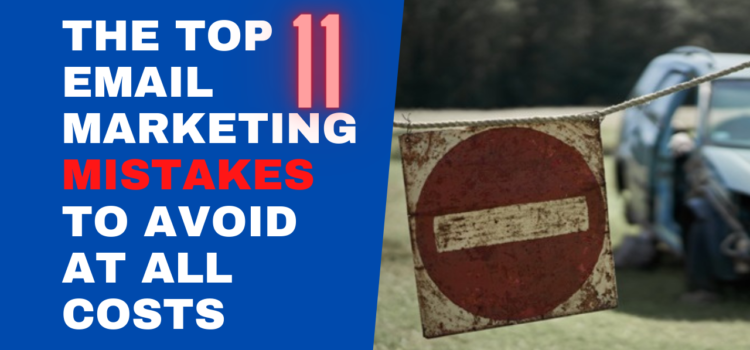Email marketing can be an e-commerce company’s best friend — or its worst enemy. When email campaigns are well executed, they attract new customers, build customer loyalty, and generate orders for new items. However, when email marketing execution goes wrong, emailing drives prospects away, worsens brand perception and customer loyalty, and even contributes to a loss of revenue. To do email marketing properly and avoid marketing mistakes, you need to get rid of these 11 critical errors.
Table of contents
- 1. Emailing without permission
- 2. Making opting in too hard
- 3. Not designing for mobile
- 4. Having weak or nonexistent calls to action
- 5. Being impersonal
- 6. Using too much text
- 7. Not using enough text
- 8. No split testing
- 9. Not using customized landing pages
- 10. Emailing too frequently
- 11. Emailing too infrequently
- Avoid 11/11, nothing less
1. Emailing without permission
For email recipients, maintaining control of their inboxes and avoiding spam are tremendously important. Nothing turns off prospects or customers faster than being hit with email marketing sent without their permission. To avoid irritating recipients, make sure everyone on your list has opted in. This important point of email marketing execution, by the way, is one of the main reasons buying lists is so ineffective and potentially dangerous to your brand.
2. Making opting in too hard

If an opt-in mailing list is priority number one, then making it difficult for customers and prospects to opt in is problem number one. Your website’s home page, product information pages, and about pages should have prominent email signup boxes. For the mobile version of your site, seriously consider keeping the email signup link fixed at the top of each page. this is another simple trick to avoid marketing mistakes.
3. Not designing for mobile
Since we’re talking about mobile viewing, your emails themselves should be designed to create a fabulous mobile user experience. If recipients are forced to pinch and zoom to make sense of your message, they probably won’t take the time to try. In addition, poor mobile design conveys the impression you don’t really understand basic customer needs, which is poison for brand perception.
4. Having weak or nonexistent calls to action
After recipients read your email, do they know what to do next? If so, are you giving them an incentive to do it? If the answer to either question is anything less than an exuberant “yes,” you are not ready to launch that email. Make it easy for customers to say “yes” by providing a clear and concise call to action with a great incentive.

5. Being impersonal
Each of your email recipients wants to feel like your only customer. Every year getting away with generic emails gets harder and harder, because personalization technology is now so easy to use that everybody uses it. Recipients now expect personalized subject lines and greetings, and even offers personalized around their buying or browsing histories.
6. Using too much text

Most recipients are interested in one thing: What’s in it for me? If you have a great offer, get to the point. Forcing recipients to wade through paragraphs of copy — particularly on mobile devices — causes user anxiety and frustration. If lengthy text is unavoidable, kick off the email with an executive summary and a call to action, with the lengthy supporting text below. Recipients who want the details will continue reading.
7. Not using enough text
The flipside error is not using enough text when longer explanations are needed. Longer copy works well when describing complex features and benefits, and when introducing a new product or service. The challenge is to find the happy balance that provides enough information to generate click-throughs but not so much information to discourage them.
8. No split testing
This issue of short versus long copy brings us to the very important issue of split testing. Arguably the greatest advantage of email is the ability to continuously improve campaigns through systematic testing. However, the greatest tragedy of email occurs when e-commerce companies fail to test or fail to test systematically. Subject lines, copy length, offers, calls to action, design elements, launch timing — all these areas should be tested and re-tested, analyzed and re-analyzed to avoid marketing mistakes.
9. Not using customized landing pages

Getting a click-through is an email “win,” but the real payoff is not the click-through but the order. Sending users to a generic page or one that is not 100% relevant to the email discourages orders to a significant degree. Therefore, customized landing pages fully dedicated to the email make the difference. For instance, if you mention an offer in the email, the recipient expects the details on the landing page. If those details are not there, you will need a truly amazing offer for the recipient to bother hunting around your website for it. And of course, split testing landing pages (see #8 above) is a must.
10. Emailing too frequently
Our email boxes are perpetually full. Unless you have 60 extraordinary messages to share, 60 emails a month is far too many and will annoy subscribers mightily. Don’t wait for unsubscribe statistics to verify the need to cut back; instead, use common sense. If you really have that much to communicate, consider offering multiple email subscriptions — one for special offers, one for product information, one for company news, etc.
— You may be interested in these case studies
11. Emailing too infrequently

Emailing too infrequently is also a major marketing error. If months pass between emails, recipients might think you’re unenthusiastic about your own business (so why should they be enthusiastic?). In addition, a certain amount of repetition is needed for a message to sink in. For topics such as time-sensitive offers, sending gentle email reminders makes sense. If the timing of those reminders is right — say, once a week rather than hourly — subscribers will appreciate your interest in helping them save money.
Avoid 11/11, nothing less
Perhaps the biggest e-commerce email marketing mistake of all is to fix some problems but allow others to persist. Any one of these 11 problems is enough to reduce CTRs and conversions all by itself. Your budget and available time and talent may not allow you to fix every problem at once, but that’s O.K. The important things are to identify the problems, create a realistic timetable for correcting them, and get to work. As time goes on, the improvements you make will enable your results to steadily improve too.
[yasr_visitor_votes]

